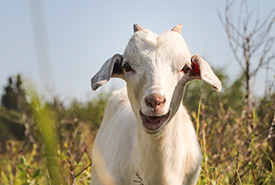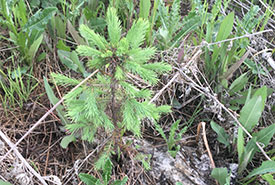Goats: Unlikely heroes in ecological restoration
Goats are voracious predators of troublesome weeds
A hungry goat (Photo by NCC)
Ecological restoration is an important endeavour in our efforts to slow the pace of climate change and conserve biodiversity. One innovative approach to this challenging task involved an unlikely ally: goats.
The Nature Conservancy of Canada (NCC) is working to restore former cropland to mixedwood forest at our Fleming Property, located northeast of Spruce Grove, Alberta. Here, restoration specialists are combining conservation, sustainable weed control and innovative practices to create and reconnect forest habitats for the benefit of both people and nature.
A unique challenge
The Fleming Property boasts a rich natural landscape, with mixedwood boreal forest and wetlands providing vital habitat for wildlife, including birds such as warblers and woodpeckers. However, part of this site was once used for farming crops, which NCC restoration staff are working to return to forest.
First, native grasses were planted to provide ground cover, which helps build soil and control erosion. Then spruce trees were planted on the former crop land to start the restoration process. However, the restoration team encountered a challenge when invasive weed species took root among the newly planted trees: the weeds compete with the tree seedlings for water and nutrients, stunting their growth. Pulling and herbicide use were not good options to control the weeds due to the potential harm they posed to the delicate tree seedlings. Faced with this dilemma, the team turned to an unconventional but highly effective solution: goats.
Enjoying this story? Sign up for our newsletter!
Four-legged weed warriors
Beginning in 2018, about 500 goats were brought each summer to the Fleming Property, accompanied by a skilled herder and shepherding dogs. These goats worked around the clock and were monitored to ensure they were eating the target invasive plants.

Spruce seedling at the Fleming Property (Photo by NCC)
Goats work for restoration because they tend to prefer to eat weeds, and because of this, their use in restoration is known as target browsing. Temporary electric fencing was put in place to concentrate the goats' efforts on the targeted areas and to prevent them from wandering off.
Despite their voracious appetite for weeds, the goats tended to stick together, moving methodically across the land to devour the unwanted vegetation, explains Alia Snively, who leads NCC's restoration work in Alberta.
“It’s very intensive, but the herders make sure that the goats are primarily eating the weeds and move them to a new area if they start to nibble on the desirable vegetation,” says Alia. “It’s a great way to organically and selectively control weeds.”
But using goats to control invasive plants requires knowledge of livestock and land, and the goats must be carefully directed and managed, says Alia.
Multiple benefits of goat grazing
Beyond weed control, the goats also provide other ecological benefits. They help reduce the accumulation of litter, which is the decaying plant matter on the soil's surface. While litter is essential for moderating soil temperatures and moisture levels, excessive buildup can hinder germination and plant growth. The goats' grazing habits help maintain a healthy balance of litter, improving the ecological conditions for forest regeneration.
Expanding biodiversity
With the invasive weeds successfully controlled by the goats, the restoration team could progress to the next phase of their project. This phase involved introducing greater biodiversity to the site. To do this, the team purchased five different species of native shrubs, totalling 276 shrubs, which were planted in September.
“We were there in July, and when we were walking around the site, we saw some native shrubs moving in as well,” says Alia. “It was a very encouraging sign to see.”
To help ensure the shrubs thrive, the restoration team will install "mulch mats" around them. These biodegradable mats serve to suppress surrounding vegetation by blocking light, allowing the newly planted shrubs to establish themselves and contribute to the site's increasing biodiversity.
Want to support our restoration work? Consider donating to NCC today!
The road to restored
The use of goats in ecological restoration at the Fleming Property is a remarkable example of creative problem-solving and sustainable restoration practices. This unconventional approach effectively controlled invasive weeds while clearing the way for the restoration of a diverse boreal forest ecosystem.
Note: Goats are not used at NCC properties where there is potential for native mountain goats or bighorn sheep to be present, to avoid any potential risk of disease transmission.




